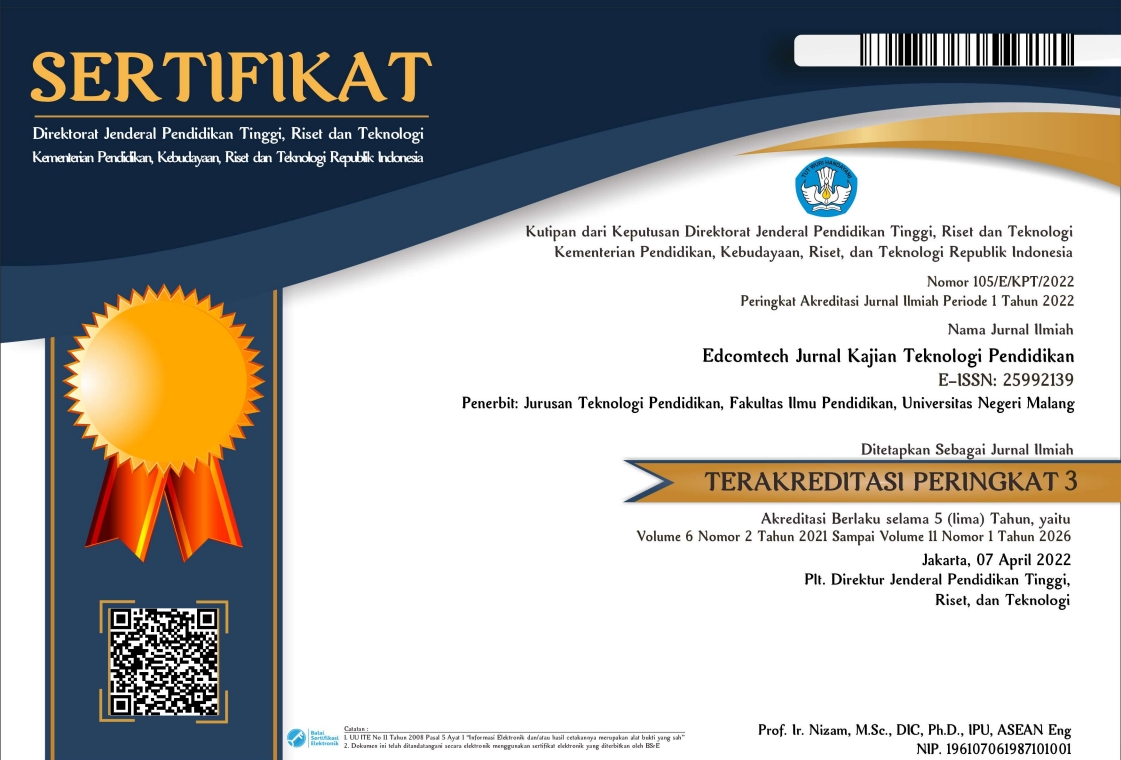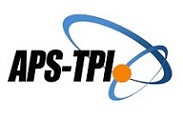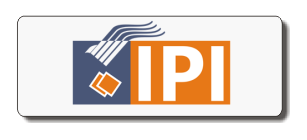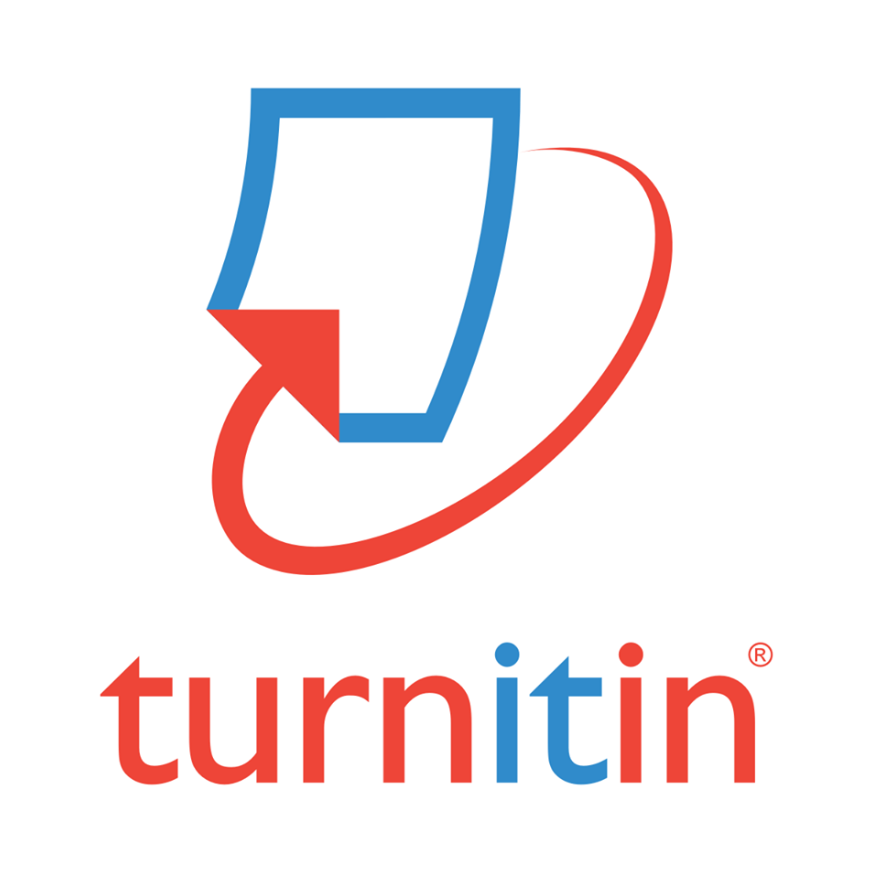Penelitian dan Pengembangan E-Module Geometri Berdasarkan Fase Pembelajaran Geometri
Abstract
Abstrak: Pembelajaran geometri tidak terlepas dari fase pembelajaran geometri yang berlandaskan pada teori Van Hiele untuk meningkatkan level berfikir geometri pada siswa. E-module geometri yang disusun berdasarkan fase pembelajaran geometri berperan sebagai bahan ajar pada pembelajaran secara daring maupun luring. Penelitian ini bertujuan untuk mengembangkan e-module geometri khususnya pada materi segiempat dengan model pengembangan ADDIE oleh Branch. Subjek penelitian menggunakan siswa kelas VII SMP di Malang sebanyak 18 orang. Hasil pengembangan telah divalidasi oleh beberapa ahli dengan kategori sangat valid. Sedangkan efektivitas dari e-module geometri ditentukan dengan melihat nilai g yang mencapai angka 0.3, yang menunjukkan bahwa e-module geometri cukup efektif pada peningkatan hasil belajar materi segiempat. Selain itu e-module dapat diimplementasikan pada proses pembelajaran baik di kelas maupun pembelajaran jarak jauh.
Abstract: The concept of learning geometry is based on phases of learning geometry, by Van Hiele, which enhances about students’ levels of geometric thinking. Drafting geometry e-module based on phases of learning geometry becomes one of the teaching materials and has a role in online and offline learning. This study focuses on developing a geometry e-module, on quadrilaterals. The development model used ADDIE by Branch. The research is participated by 18 students of grade VII in secondary school on Malang. The product has been validated by experts, which were perfectly valid. Meanwhile, the effect of the e-module is determined by looking at the gain score, was 0.3, which indicates that geometry e-module is quite effective in enhancing learning outcomes of quadrilaterals and implemented in classroom or distance learning.
Keywords
Full Text:
PDFReferences
Abdullah, A. H., & Zakaria, E. (2012). The Activities Based on Van Hiele’s Phase-Based Learning: Experts’ and Preservice Teachers’ Views. Journal of Mathematics and Statistics, 8(3), 385–395. https://doi.org/10.3844/jmssp.2012.385.395
Abdullah, A. H., & Zakaria, E. (2013a). Enhancing Students’ Level of Geometric Thinking Through Van Hiele’s Phase-based Learning. Indian Journal of Science and Technology, 6(5), 1–15. https://doi.org/10.17485/ijst/2013/v6i5.13
Abdullah, A. H., & Zakaria, E. (2013b). The Effects of Van Hiele’s Phases of Learning Geometry on Students’ Degree of Acquisition of Van Hiele Levels. Procedia - Social and Behavioral Sciences, 102, 251–266. https://doi.org/10.1016/j.sbspro.2013.10.740
Akbar, S. (2013). Instrumen Perangkat Pembelajaran. PT Remaja Rosdakarya.
Argaswari, D. P. A. D. (2018). Penelitian dan Pengembangan Modul Pembelajaran Geometri Berbasis Teori Van Hiele. HISTOGRAM: Jurnal Pendidikan Matematika, 2(2), 108-119. https://doi.org/10.31100/histogram.v2i2.211
Arsyad. (2009). Media Pembelajaran. PT Grafindo Persada.
Astalini, A., Darmaji, D., Kurniawan, W., Anwar, K., & Kurniawan, D. A. (2019). Effectivenes of Using E-Module and E-Assessment. International Journal of Interactive Mobile Technologies (IJIM), 13(09), 21–39. https://doi.org/10.3991/ijim.v13i09.11016
Branch, R. M. (2009). Instructional Design: The ADDIE Approach. Springer US. https://doi.org/10.1007/978-0-387-09506-6
Cahyaningrum, A. O. (2016). Analisis Kesulitan Menyelesaikan Soal Geometri Ditinjau Dari Level Berpikir. Publikasi Ilmiah, 10. http://v2.eprints.ums.ac.id/archive/etd/44619/2/4
Clark, R. E., & Salomon, G. (2011). Media Theory. In R. C. Richey, J. D. Klein, & M. W. Tracey (Eds.), The Instructional Design Knowledge Base: Theory, Research, and Practice (pp. 84–101). Routledge.
Connolly, S. (2010). The Impact of van Hiele-based Geometry Instruction on Student Understanding. St. John Fisher College.
Depdiknas. (2008). Penulisan Modul. Direktorat Tenaga Kependidikan Direktorat Jenderal Peningkatan Mutu Pendidik dan Tenaga Kependidikan Departemen Pendidikan Nasional.
Dick, W., Carey, L., & Carey, J. O. (2015). The Systematic Design of Instruction (Eighth edition). Pearson.
Dongwi, B. L. (2014). Using the Van Hiele Phases of Instruction to Inform the Design and Implementation of a Circle Geometry Teaching and Learning Programme. In Namibia Counts: Mathematics Education Research in Namibia (pp. 107–119). Digital Print Solutions. https://www.researchgate.net/publication/333647851
Fuys, D. J., Geddes, D., & Tischler, R. W. (1984). English Translation of Selected Writings of Dina van Hiele-Geldof and Pierre M. van Hiele. ERIC.
Graesser, A. C., Chipman, P., & King, B. G. (2011). Media Theory. In R. C. Richey, J. D. Klein, & M. W. Tracey (Eds.), The Instructional Design Knowledge Base: Theory, Research, and Practice (pp. 84–101). Routledge.
Griffin, P., McGaw, B., & Care, E. (2012). Assessment and Teaching of 21st Century Skills. Springer.
Hake, R. R. (1998). Interactive-Engagement Versus Traditional Methods: A Six-Thousand-Student Survey of Mechanics Test Data for Introductory Physics Course. American Journal of Physics, 66(1), 64–74. https://doi.org/10.1119/1.18809
Hanafi, M. A. (2017). Deskripsi Kesulitan Belajar Geometri Mahasiswa Program Studi Pendidikan Matematika Fakultas Keguruan dan Ilmu Pendidikan Universitas Cokroaminoto Palopo. Prosiding Seminar Nasional, 3, 273–283. http://journal.uncp.ac.id/index.php/proceeding/article/view/797
Indrayany, E. S., & Lestari, F. (2019). Analisis Kesulitan Siswa SMP Dalam Memecahkan Masalah Geometri Dan Faktor Penyebab Kesulitan Siswa Ditinjau Dari Teori Van Hiele. Jurnal Math Educator Nusantara: Wahana Publikasi Karya Tulis Ilmiah di Bidang Pendidikan Matematika, 5(2), 109–123. https://doi.org/10.29407/jmen.v5i2.13729
Ismail. (2009). Fase-Fase Pembelajaran Geometri. In Purwoko (Ed.), Teori Belajar Van Hiele. Konsorsium PJJ S1 PGSD.
Jones, K. (2002). Issues in the Teaching and Learning of Geometry. In L. Haggarty (Ed.), Aspects of Teaching Secondary Mathematics: Perspectives on practice (pp. 121–139). RoutledgeFalmer.
Kemendikbud. (2014). Peraturan Menteri Pendidikan dan Kebudayaan, Nomor 58, Tahun 2014, tentang Kurikulum 2013 Sekolah Menengah Pertama (SMP) / Madrasah Tsanawiyah (MTs).
Levie, W. H., & Lentz, R. (1982). Effects of Text Illustrations: A Review of Research. Educational Communication and Technology: A Journal of Theory, Research, and Development, 30(4), 195–232.
Midgett, C. W., & Eddins, S. K. (2001). NCTM’s Principles and Standards for School Mathematics: Implications for Administrators. NASSP Bulletin, 85(623), 35–42. https://doi.org/10.1177/019263650108562305
Musdi, E., & Gusnita, N. (2018). Development of Mathematical Learning Devices Using Van Hiele Theory in Geometry of The Students In Grade VIII Secondary High School. Proceedings of the 2nd International Conference on Mathematics and Mathematics Education 2018 (ICM2E 2018), 54–57. https://doi.org/10.2991/icm2e-18.2018.14
Musser, G. L., Burger, W. F., & Peterson, B. E. (2013). Mathematics for Elementary Teachers (8th ed.). John Wiley & Sons, Inc.
Prensky, M. (2001). Digital Natives, Digital Immigrants Part 1. On the Horizon, 9(5), 1–6. https://doi.org/10.1108/10748120110424816
Purwoko. (2009). Teori Belajar Van Hiele. In Elang K (Ed.), Paket Bahan Ajar PJJ S1 PGSD. Direktorat Jendral Pendidikan Tinggi.
Rusman. (2017). Belajar dan Pembelajaran Berorientasi Standar Proses Pendidikan. Prenadamedia Group.
Siew, N. M., Chong, C. L., & Abdullah, M. R. (2013). Facilitating Students’ Geometric Thinking Through Van Hiele’s Phase-Based Learning Using Tangram. Journal of Social Sciences, 9(3), 101–111. https://doi.org/10.3844/jsssp.2013.101.111
Smaldino, S. E., Lowther, D. L., & Russel, J. D. (2011). Teknologi Pembelajaran dan Media untuk Belajar (A. Rahman, Trans.). Prenadamedia Group.
Sugiyono. (2019). Metode Penelitian Pendidikan. Alfabeta.
Sutama, I. K., Suharta, I. G. P., & Suweken, G. (2014). Pengembangan Perangkat Pembelajaran Geometri SMA Berdasarkan Teori Van Hiele Berbantuan Wingeom Dalam Upaya Meningkatkan Aktivitas dan Hasil Belajar Siswa. Jurnal Pendidikan dan Pembelajaran Matematika Indonesia, 3(1), 1-14.
Zubaidah, S. (2016). Keterampilan Abad Ke-21: Keterampilan yang Diajarkan Melalui Pembelajaran. Seminar Nasional Pendidikan dengan Tema “Isu-Isu Strategis Pembelajaran MIPA Abad 21", 21, 2–3.
DOI: http://dx.doi.org/10.17977/um039v6i12021p288
Refbacks
- There are currently no refbacks.
Copyright (c) 2021 Vina Muthmainna Rianto

This work is licensed under a Creative Commons Attribution-ShareAlike 4.0 International License.
Edcomtech: Jurnal Kajian Teknologi Pendidikan published by Department of Educational Technology, Faculty of Education, State University of Malang in Collaboration with Asosiasi Program Studi Teknologi Pendidikan Indonesia (APS TPI) and Ikatan Profesi Teknologi Pendidikan Indonesia (IPTPI) with MoU.
Publisher Address:
Lab. Teknologi Pendidikan, Gd.E2, Lt.1
Fakultas Ilmu Pendidikan Universitas Negeri Malang
Jalan Semarang No 5, Kota Malang Kode Pos 65145
Email: edcomtech.fip@um.ac.id
========================================================================================================
| INDEXED BY | TOOLS | PLAGIARISM CHECK | ARTICLE TEMPLATE |
|

Edcomtech is licensed under a Creative Commons Attribution-ShareAlike 4.0 International License.
Edcomtech Statistics (Since July 13th, 2020)












1.png)








